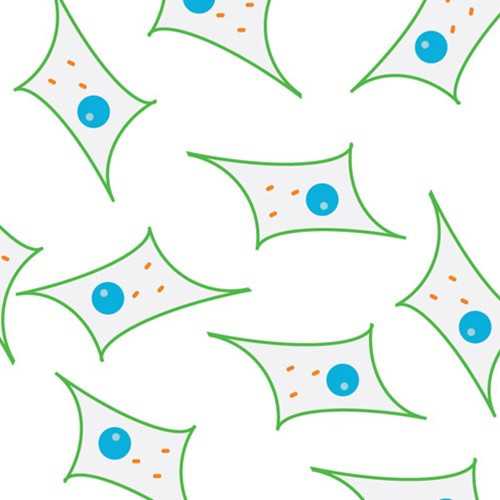BMP Responsive Reporter Osteoblast Cell Line (BRITER)
BMP responsive reporter cell line with dual luciferase reporter construct made using immortalized calvarial osteoblast cells isolated from tamoxifen inducible Bmp2/Bmp4 double conditional knockout mouse strain.
Highlights
- Cells are highly sensitive to exogenous BMP protein and robustly report active BMP signaling
- Capable of undergoing osteogenic differentiation in graded response to active BMP signaling
- Cells can be depleted of BMP2 and BMP4 proteins upon treatment with 4-hydroxytamoxifen
- Contains a BMP responsive dual luciferase reporter, which includes an internal control
Bone Morphogenetic Proteins (BMPs) are a group of growth factors or cytokines which belongs to transforming growth factor beta (TGF-β) superfamily. There are at least 20 related BMPs known to contribute to embryogenesis and morphogenesis of various tissues and organs. BMPs are used to induce the formation of bone and cartilage during fracture healing and bone repair. BMP2 and BMP4 are two most osteogenic BMPs and have been demonstrated to induce osteogenic differentiation in a variety of cell types. Misregulation of the BMP signaling can leads to several developmental disorders and cancer, specifically in the progression of colon cancer. In contrast, over-activation of BMP signaling can leads to Barrett's oesophagus and several skeleton abnormalities [3, 4].
From the laboratory of Amitabha Bandyopadhyay, PhD, Indian Institute of Technology Kanpur.
BMP responsive reporter cell line with dual luciferase reporter construct made using immortalized calvarial osteoblast cells isolated from tamoxifen inducible Bmp2/Bmp4 double conditional knockout mouse strain.
Highlights
- Cells are highly sensitive to exogenous BMP protein and robustly report active BMP signaling
- Capable of undergoing osteogenic differentiation in graded response to active BMP signaling
- Cells can be depleted of BMP2 and BMP4 proteins upon treatment with 4-hydroxytamoxifen
- Contains a BMP responsive dual luciferase reporter, which includes an internal control
Bone Morphogenetic Proteins (BMPs) are a group of growth factors or cytokines which belongs to transforming growth factor beta (TGF-β) superfamily. There are at least 20 related BMPs known to contribute to embryogenesis and morphogenesis of various tissues and organs. BMPs are used to induce the formation of bone and cartilage during fracture healing and bone repair. BMP2 and BMP4 are two most osteogenic BMPs and have been demonstrated to induce osteogenic differentiation in a variety of cell types. Misregulation of the BMP signaling can leads to several developmental disorders and cancer, specifically in the progression of colon cancer. In contrast, over-activation of BMP signaling can leads to Barrett's oesophagus and several skeleton abnormalities [3, 4].
From the laboratory of Amitabha Bandyopadhyay, PhD, Indian Institute of Technology Kanpur.
| Product Type: | Cell Line |
| Name: | BRITER |
| Cell Type: | Osteoblast |
| Accession ID: | CVCL_0P40 |
| Organism: | Mouse |
| Source: | Calvaria |
| Morphology: | Fibroblast |
| Biosafety Level: | BSL1 |
| Growth Conditions: | DMEM + 10 % FBS (Pen/Strep @ concentration standard) |
| Subculturing: | Can be sub-cultured using standard cell culture protocols |
| Cryopreservation: | Growth medium containing 50% FBS +7% DMSO |
| Comments: | The reporter construct contains BRE driven Firefly Luciferase gene (FFLuc) and SV40 promoter/enhancer driven Renilla luciferase (RRLuc) gene, to serve as an internal normalization control for cell number as well as non-specific transcription activation |
| Storage: | Liquid nitrogen |
| Shipped: | Dry ice |
Validation of Cell Line

BMP2 dependent FFLuc activity of BRITER cell line under four different conditions, namely 2BMP. 24-OHT, 2BMP, +4-OHT, +BMP, +4-OHT and +BMP, 24-OHT. BMP (bone morphogenetic protein 2) and OHT (hydroxytamoxifen).
Adapted from: Yadav PS., et al. PLoS One. 2012;7(5):e37134.
- Yadav PS, Prashar P, Bandyopadhyay A. BRITER: a BMP responsive osteoblast reporter cell line. PLoS One. 2012;7(5):e37134.
- Nyamsuren G, Kata A, Xu X, Raju P, Dressel R, Engel W, Pantakani DV, Adham IM. Pelota regulates the development of extraembryonic endoderm through activation of bone morphogenetic protein (BMP) signaling. Stem Cell Res. 2014 Jul;13(1):61-74.
- Bandyopadhyay, A., P.S. Yadav, and P. Prashar, BMP signaling in development and diseases: a pharmacological perspective. Biochem Pharmacol, 2013. 85(7): p. 857-64.
- Prashar, P., et al., Microarray meta-analysis identifies evolutionarily conserved BMP signaling targets in developing long bones. Dev Biol, 2014. 389(2): p. 192-207.
- Nolan K, Kattamuri C, Rankin SA, Read RJ, Zorn AM, Thompson TB. Structure ofGremlin-2 in Complex with GDF5 Gives Insight into DAN-Family-Mediated BMPAntagonism. Cell Rep. 2016 Aug 23;16(8):2077-86. View Article
- Yu L, Dawson LA, Yan M, Zimmel K, Lin YL, Dolan CP, Han M, Muneoka K. BMP9 stimulates joint regeneration at digit amputation wounds in mice. Nat Commun. 2019 Feb 5;10(1):424. View Article
If you publish research with this product, please let us know so we can cite your paper.


